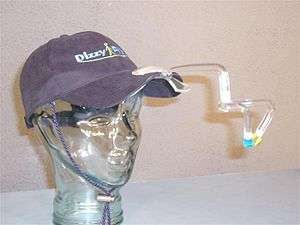DizzyFIX
The DizzyFIX is an FDA cleared home medical device available to assist in the treatment of Benign paroxysmal positional vertigo (BPPV) and its associated vertigo.[1] The device itself is a head-worn representation of semi-circular canals. The device is filled with fluid and a particle representing the otoconia (loose hard particles) associated with BPPV. The device works like a visual set of instructions and guides the user through the treatment maneuver for BPPV. This maneuver is called the particle repositioning maneuver or Epley maneuver. This product has been discontinued by the manufacturer.

BPPV

BPPV is the most common cause of peripheral vertigo.[2] It can be characterized by three main symptoms: positional onset, spinning dizziness and short lived symptoms. The primary diagnostic maneuver is the Dix-Hallpike which elicits the cardinal sign associated with BPPV, rotatory nystagmus.
Background
The DizzyFIX was originally developed by otolaryngologists (ENT physicians) to assist in the long term treatment of patients with a known history of recurrent BPPV. BPPV is frequently highly recurrent with rates as high as 50%.[3] Radtke et al. have suggested that home treatment is both safe and effective when training is adequate but that the key cause of failure of the home treatment is an imperfect repositioning maneuver.[4] As a result of failed home treatments the DizzyFIX was developed to assist patients in the performance of a correct particle repositioning maneuver. Research to date indicates that use of the device is correlated with a correct particle repositioning maneuver.[1]
See also
References
- Beyea, Jason Atkins; Wong, Eric; Bromwich, Matthew; Weston, W Wayne; Fung, Kevin (2008). "Evaluation of a Particle Repositioning Maneuver Web-Based Teaching Module". The Laryngoscope. 118 (1): 175–80. doi:10.1097/MLG.0b013e31814b290d. PMID 18251035.
- Nedzelski, JM; Barber, HO; McIlmoyl, L (1986). "Diagnoses in a dizziness unit". The Journal of otolaryngology. 15 (2): 101–4. PMID 3712537.
- Nunez, Robert A.; Cass, Stephen P.; Furman, Joseph M. (2000). "Short- and long-term outcomes of canalith repositioning for benign paroxysmal positional vertigo". Otolaryngology–Head and Neck Surgery. 122 (5): 647–52. doi:10.1016/S0194-5998(00)70190-2. PMID 10793340.
- Radtke, A.; Von Brevern, M.; Tiel-Wilck, K.; Mainz-Perchalla, A.; Neuhauser, H.; Lempert, T. (2004). "Self-treatment of benign paroxysmal positional vertigo: Semont maneuver vs Epley procedure". Neurology. 63 (1): 150–2. doi:10.1212/01.WNL.0000130250.62842.C9. PMID 15249626.
External links
- DizzyFIX Home treatment device